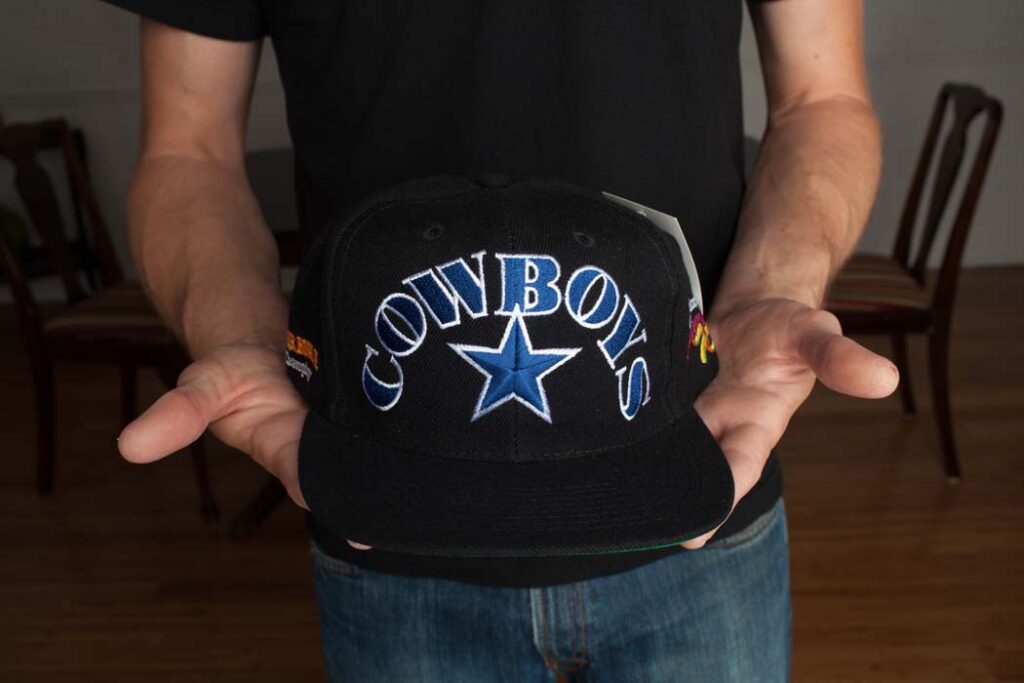
Lake Highlands, TX 10/04/15 A throwback Dallas Cowboys hat Lake Highlands resident and director Madison Liane posseses. Photo Credit: Rasy Ran
Audience
- Sentiment: Neutral/Reflective
- Political Group: None specified
- Age Group: Young adults and sports fans
- Gender: Male
Overview
- The article discusses the backlash and death threats aimed at Mavericks GM Nico Harrison following the trade of Luka Doncic.
- Two reporters, Tim MacMahon and Grant Afseth, clash over the authenticity of the reported threats, leading to a media rivalry.
- The situation reflects broader issues of media responsibility and the impact of public opinion in the realm of sports.
Mavericks Reporters Clash Over Death Threats Against GM Nico Harrison: A Deep Dive into the Drama Behind the Headlines
In the world of sports, especially when it comes to passionate teams like the Dallas Mavericks, emotions run high. Fans can sometimes react in extreme ways when they feel their team is making poor decisions. Recently, things took a dramatic turn when reports surfaced about death threats aimed at Mavericks General Manager (GM) Nico Harrison following the controversial trade of superstar Luka Doncic to the Los Angeles Lakers. What followed has been a rollercoaster of accusations, rebuttals, and a clash between reporters that has left many people asking: what really happened?
Let’s break down this story and try to understand the layers involved, from the trade that stirred the pot to the media fallout that has kept it boiling.
The Trade That Shook Maverick Nation
First, let’s talk about the trade itself. Luka Doncic is more than just another player; he is a phenomenon. Since joining the Mavericks, he has been known for his incredible skill on the court, his ability to make clutch plays, and his talent to bring fans to their feet. Thus, when the news broke that he had been traded to the Los Angeles Lakers, fans were understandably furious. To many, this move felt like a betrayal from the team’s management, especially since Doncic was seen as the face of the franchise.
Imagine being a die-hard fan and waking up to find your favorite player has been traded overnight. It’s devastating! The anguish was palpable, and it wasn’t long before social media lit up with messages of frustration, anger, and, sadly, threats. This is where the drama escalates, leading to the claims of death threats against GM Nico Harrison.
The Initial Claims
The first to report on the death threats was ESPN’s Tim MacMahon. During one of his podcasts, MacMahon stated that Harrison had indeed received threats from fans who were upset with the trade. His assertion was serious – death threats are no joke and can create dangerous situations. In his defense, MacMahon claimed that he had multiple sources confirming the existence of these threats.
This was a significant accusation, and it set the stage for everything that followed. After all, when you have a respected sports journalist like MacMahon making such a bold claim, people will listen. But as is often the case in journalism, once the initial report is made, it becomes a hot topic open for debate and scrutiny.
The Counterargument
Enter independent journalist Grant Afseth. After hearing about the reported threats, Afseth decided to do his own digging. He reached out to the Dallas Police Department for clarity on the matter. What he discovered was surprising – the police found no record of any death threats made against Harrison. This contradicted MacMahon’s claims and set the stage for a clash of opinions in the media.
Afseth took to social media and other platforms to refute MacMahon’s assertions, emphasizing that it was unfair to tarnish Dallas’s reputation over what he believed to be unfounded claims. He voiced his concerns not just as a journalist, but as a local citizen who cares about how the actions of a few disgruntled fans could negatively affect the city and the team.
The Back-and-Forth Battle
With both reporters standing firm in their positions, tensions soared. MacMahon didn’t take too kindly to Afseth’s criticisms. During another podcast, he slammed Afseth as a “wannabe journalist,” arguing that he had solid sources that verified his claims. This not only intensified the rivalry between the two reporters but also had fans divided. Some rallied behind MacMahon, claiming that he was merely reporting the truth of a volatile situation, while others sided with Afseth, feeling that his commitment to accuracy was commendable.
This kind of back-and-forth isn’t uncommon in the world of journalism, especially in the sports arena where stakes are high and passions run wild. However, what made this instance stand out was how it reflected broader issues in media and reporting, especially regarding how quickly information spreads and how it can influence public perception.
The Aftermath and Fan Reactions
As the drama escalated between the reporters, the Mavericks themselves were facing a barrage of backlash from their fanbase. When the team loses a star player like Doncic, it creates not just disappointment but also a feeling of betrayal. Fans began expressing their frustrations loudly during games, sending messages through social media, booing during plays, and demanding accountability from the team’s management.
This situation raises important questions about the media’s role in shaping public opinion and the responsibilities that come with it. With rumors flying and hot takes dominating the conversation, it can sometimes be hard for fans to discern what is factual reporting and what is merely speculation.
The Bigger Picture
What’s fascinating about this story is how it encompasses more than just a sports trade. It touches on themes of accountability, transparency, and the power of both media and fans in shaping narratives. In a climate where outrage can fuel conversations online, both fans and reporters need to exercise caution. Reporting on sensitive issues, especially those related to threats and personal safety, holds a heavy weight and should be approached with care and responsibility.
For many young people, navigating this world of information is crucial. As you scroll through social media, it can be easy to take claims at face value. However, understanding who is reporting the news and where their information comes from is key. It’s a good practice to ask questions and look for multiple sources before forming an opinion—especially in a world where misinformation can spread like wildfire.
Conclusion: A Call for Reflection
So, where does this leave us? The conflict between two reporters highlights the sometimes tumultuous relationship between fans, the media, and the teams they love. As we continue to follow the Mavericks and what happens next in their journey, let’s take a moment to reflect on the importance of careful reporting, respectful fan engagement, and the need for dialogue that fosters understanding rather than division.
How do you think the media should handle allegations like those made against Nico Harrison? Do you believe the reaction from fans is justified, or do you think it can go too far? I’d love to hear your thoughts—drop a comment below and let’s talk about it!




